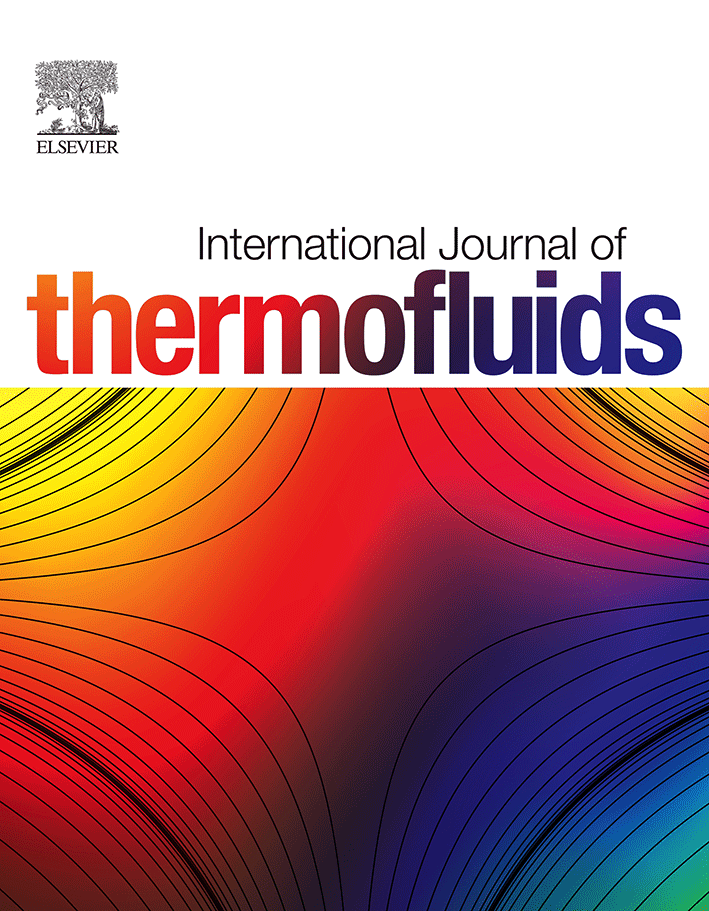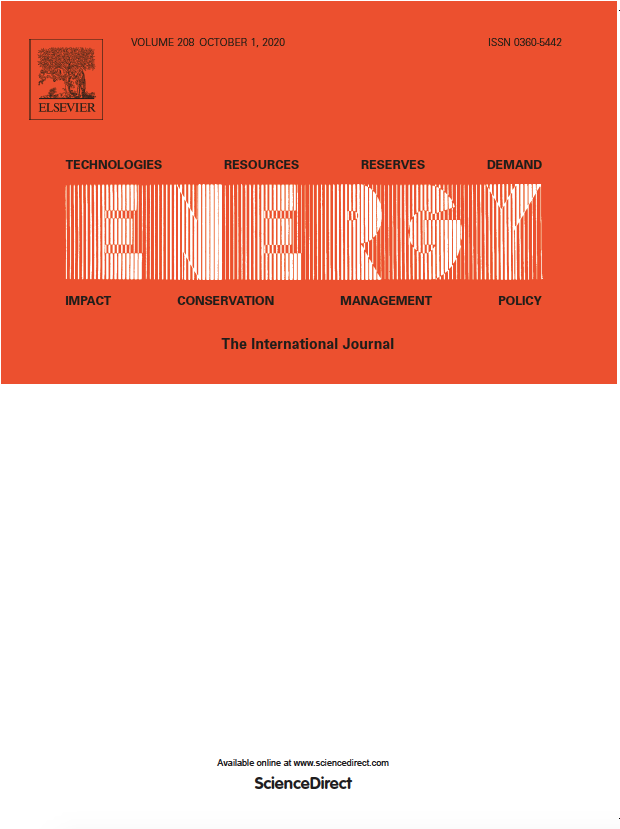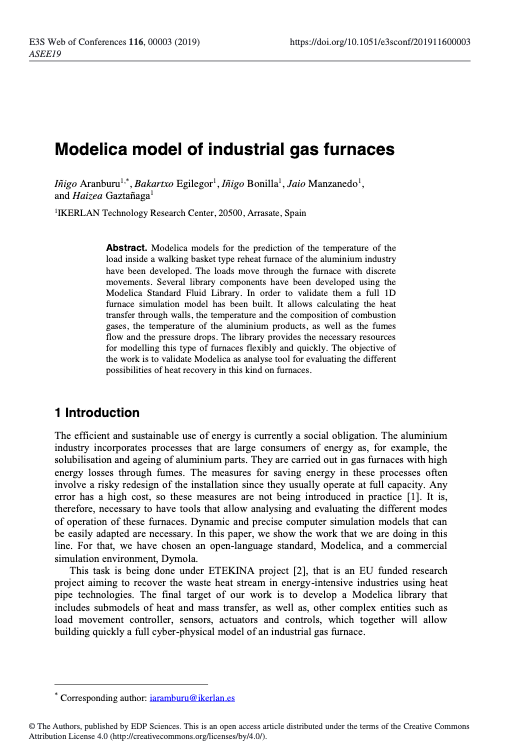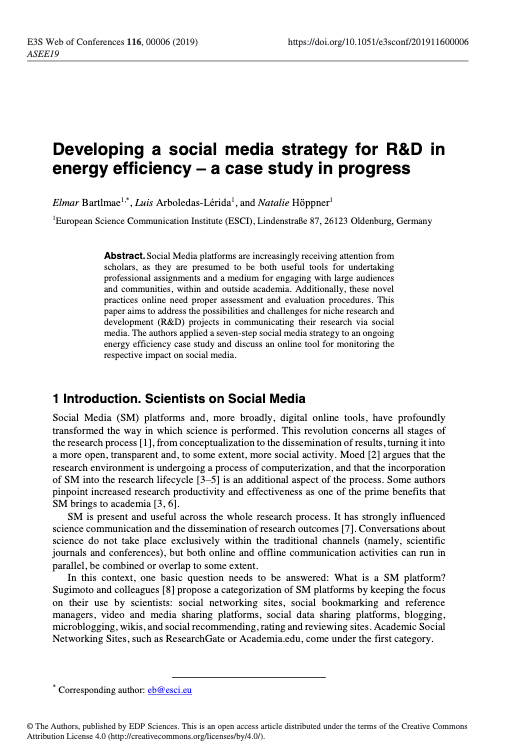Comprehensive numerical model for the analysis of potential heat recovery solutions in a ceramic industry
M. Venturelli, D. Brough, M. Milani, L. Montorsi, H. Jouhara
Heat recovery opportunities and total plant energy efficiency improvements need to be evaluated before manufacturing the real components when addressing the energy and economic effectiveness in industrial applications. Numerical modelling of the complete energy systems can be a key design tool in order to investigate the potential solutions to improve the performance of the considered system. In this study, a 0D/1D numerical analysis and transient system simulation analysis are adopted to investigate the energy efficiency enhancement given by the application of a heat pipe-based heat exchanger in the ceramic industry. The thermal power is recovered from the exhaust gases of the kilns used to fire the tiles. The numerical model includes all the main components of the heat recovery system: the primary side of the exhaust gases, the heat exchanger, the secondary circuit of the heat transfer fluid and the heat sink where the thermal power is exploited. Particular care is devoted to the modelling of the heat pipe-based heat exchanger and the necessary control strategy of the system; a specific model for the simulation of the secondary side pump is also accounted for in the analysis. The numerical results of the primary circuit are validated against experimental measurements carried out on the real ceramic facility. The good agreement between the numerical and experimental results demonstrates that the numerical model is an appropriate tool for investigating the energy efficiency enhancement of an industrial plant and for evaluating different configurations and solutions in order to fulfil the industry requirements.
To read full paper, please click on image to the left.
Investigation on a full-scale heat pipe heat exchanger in the ceramics industry for waste heat recovery
H. Jouhara, B. Delpech, B. Axcell, L. Montorsi, M. Venturelli, S. Almahmoud, M. Milani, L. Ahmad, A. Chauhan
The ceramics industry is the second largest energy consuming sector in Europe. The main energy used in the ceramics industry is heat generated through burners using natural gas. The main area can be identified in three stages, the drying stage and the firing stage, and the cooling stage. The firing stage represents about 75% of the total energy cost. The roller hearth kiln technology is considered to be the most cost-effective solution for ceramic tile manufacturing. The kiln is separated into two sections, the firing stage and the cooling stage. The cooling stage generates large amounts of waste heat as the exhaust of the kiln is composed of a challenging flue gas for heat recovery. The recovery of this heat in an efficient way with no cross contamination has been achieved with a heat pipe heat exchanger (HPHE) system, which was designed, manufactured and installed on a roller hearth kiln and is presented in this paper. The heat pipe heat exchanger located next to the cooling section exhaust stack managed to recover up to 100 kW at steady state without cross contamination or excess fouling. The return on investment of the system has been evaluated at 16 months with a saving of £30,000 per year. This paper will present a deep row by row theoretical analysis of the heat pipe heat exchanger. The Computational Fluids Dynamics will also be presented to investigate the fluid dynamics within the evaporator and condenser section. Both investigations have then been validated by the experimental investigation carried out on a full-scale industrial system. The design approach used in this paper will highlight the benefits of this type of technology and provide a guideline for the design of novel heat pipe heat exchangers.
To read full paper, please click on image to the left.
Development and validation of a TRNSYS type to simulate heat pipe heat exchangers in transient applications of waste heat recovery
D. Brough, J. Ramos, B. Delpech, H. Jouhara
Heat pipe heat exchangers (HPHEs) are being more frequently used in energy intensive industries as a method of low-grade waste heat recovery. Prior to the installation of a HPHE, the effect of the heat exchanger within the system requires modelling to simulate the overall impact. From this, potential savings and emission reductions can be determined, and the utilisation of the waste heat can be optimised. One such simulation software is TRNSYS. Currently available heat exchanger simulation components in TRNSYS use averaged values such as a constant effectiveness, constant heat transfer coefficient or conductance for the inputs, which are fixed during the entire simulation. These predictions are useful in a steady-state controlled temperature environment such as a heat treatment facility, but not optimal for the majority of energy recovery applications which operate with fluctuating conditions. A transient TRNSYS HPHE component has been developed using the Effectiveness-Number of Transfer Units (ɛ-NTU) method and validated against experimental results. The model predicts outlet temperatures and energy recovery well within an accuracy of 15% and an average of 4.4% error when compared to existing experimental results, which is acceptable for engineering applications.
Energy efficiency in the industrial sector in the EU, Slovenia, and Spain
J. Malinauskaite, H. Jouhara, B. Egilegor, F. Al-Mansour, L. Ahmad, M. Pusnik
‘Energy efficiency first’ is one of the key principles of the Energy Union, mainly due to it being the most cost effective way to reduce emissions, improving energy security, enhancing competitiveness and making energy consumption more affordable for all consumers. In light of the revised EU Energy Efficiency Directive, this paper discusses new developments brought by the EU together with the national case studies of Slovenia and Spain. Given that the paper has a specific focus on the industrial sector, it discusses the selected measures of the Energy Efficiency Directive, such as defined in Articles 7, 8, and 14, which are the most relevant to this sector. The paper also explores the newly issued integrated national energy and climate plans together with national measures and policies that support energy efficiency in industry, including the quantification of achieved and forecast energy savings in these two EU Member States.
To read full paper, please click on image to the left.
The Aluminium Industry: A Review on State-of-the-Art Technologies, Environmental Impacts and Possibilities for Waste Heat Recovery
D. Brough, H. Jouhara
Aluminium is becoming more frequently used across industries due to its beneficial properties, generally within an alloyed form. This paper outlines the entire production process of aluminium from ore to the finished metallic alloy product. In addition, the article looks at the current state of the art technologies used in each discrete process step. Particular interest is directed towards casting technologies and secondary recycling as the relative proportion of recycled aluminium is increasing dramatically and aluminium is much more energy efficient to recycle than to produce through primary methods. Future developments within the industries are discussed, in particular inert anode technology. Aluminium production is responsible for a large environmental impact and the gaseous emissions and solid residue by-products are discussed. In addition to the environmental impact, the industry is highly energy intensive and releases a large proportion of energy to atmosphere in the form of waste heat. One method of reducing energy consumption and decreasing the environmental impact of emissions is by installing waste heat recovery technology. Applied methods to reduce energy consumption are examined, with a latter focus on potential applications within the industry for waste heat recovery technologies.
Energy efficiency in industry: EU and national policies in Italy and the UK
Modelica model of industrial gas furnaces
I. Aranburu, B. Egilegor, I. Bonilla, J. Manzanedo, H. Gaztanaga
Modelica models for the prediction of the temperature of the load inside a walking basket type reheat furnace of the aluminium industry have been developed. The loads move through the furnace with discrete movements. Several library components have been developed using the Modelica Standard Fluid Library. In order to validate them a full 1D furnace simulation model has been built. It allows calculating the heat transfer through walls, the temperature and the composition of combustion gases, the temperature of the aluminium products, as well as the fumes flow and the pressure drops. The library provides the necessary resources for modelling this type of furnaces flexibly and quickly. The objective of the work is to validate Modelica as analyse tool for evaluating the different possibilities of heat recovery in this kind on furnaces.
To read full paper, please click on image to the left.
Developing a social media strategy for R&D in energy efficiency – a case study in progress
E. Bartlmae, L. Arboledas-Lérida, N. Hoeppner
Social Media platforms are increasingly receiving attention from scholars, as they are presumed to be both useful tools for undertaking professional assignments and a medium for engaging with large audiences and communities, within and outside academia. Additionally, these novel practices online need proper assessment and evaluation procedures. This paper aims to address the possibilities and challenges for niche research and development (R&D) projects in communicating their research via social media. The authors applied a seven-step social media strategy to an ongoing energy efficiency case study and discuss an online tool for monitoring the respective impact on social media.
To read full paper, please click on image to the left.
ETEKINA: Analysis of the potential for waste heat recovery in three sectors: aluminium low pressure die casting, steel sector and ceramic tiles manufacturing sector
B. Egilegor, H. Jouhara, J. Zuazua, F. Al-Mansour, K. Plesnik, L. Montorsi and L. Manzini
In the framework of the ETEKINA project, waste energy streams have been analysed at an aluminium automotive parts production facility in Spain, at a steel foundry in Slovenia and at a ceramic tile production unit in Italy. The aim is to recover more than 40% of the waste heat contained in the exhaust streams and reuse it within the industrial plant rather than emitting it to the atmosphere. To select the applications where the profitability of heat recovery can be demonstrated, the flow rates and temperatures of the applicable exhaust streams have been measured and analysed to select the processes for waste heat recovery and it’s re-used in the three industrial plants. The demonstration of the cost-effective waste heat recovery is to be made by using Heat Pipe Heat Exchangers (HPHEs) and the processes whereby the heat recovery installations will be erected have already been selected. HPHEs were selected as a heat recovery technology due to their advantages and key features over convectional heat exchangers considering space restrictions, pressure drop limitations, and other waste stream challenges. The challenges include high temperature of the waste and the heat sink streams, fluctuations in the waste stream flow rate and temperature, presence of corrosive moisture such as sulphuric acid in the waste stream, and the presence of particles in the waste stream which can cause fouling leading to failure of convectional technologies. Furthermore, HPHEs are maintenance-free and can have payback period of less than three years.
To read full paper, please click on image to the left.





